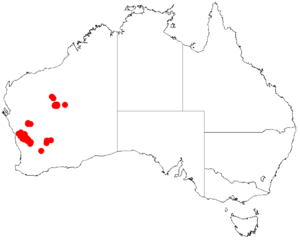Acacia daviesioides facts for kids
Quick facts for kids Acacia daviesioides |
|
|---|---|
| Scientific classification | |
| Genus: |
Acacia
|
| Species: |
daviesioides
|
 |
|
| Occurrence data from AVH | |
Acacia daviesioides is a type of shrub, part of the Acacia family. It grows naturally in Western Australia. A botanist named C.A.Gardner first described this plant in 1942. He wrote about it in the Journal of the Royal Society of Western Australia.
What Does It Look Like?
This shrub has many branches. It usually grows to be about 0.3 to 1 meter (1 to 3 feet) tall. Its stems are often straight. Sometimes, they can zig-zag a bit.
The plant has special leaf-like parts called phyllodes. These phyllodes are green and stiff. They can be flat, five-sided, or round. They are usually 2 to 20 millimeters (0.08 to 0.79 inches) long. They might curve slightly or be straight.
A. daviesioides produces yellow flowers. These flowers bloom between June and September. After flowering, the plant forms seed pods. These pods are long and narrow. They are 4 to 8 centimeters (1.6 to 3.1 inches) long. They are also 3 to 5 millimeters (0.12 to 0.20 inches) wide. The seeds inside are ready by December.
This shrub is similar to another plant called Acacia cerastes. Both grow near Mount Gibson, north of Kalannie. You can tell A. daviesioides apart because its stems are not twisted. Also, its phyllodes are not sharp.
Where Does It Grow?
A. daviesioides likes to grow in different types of soil. You can find it in loamy, sandy-clay, sandy, or gravelly soils. It often grows in low-lying areas or on sandplains. It can also be found on stony slopes. It grows among other plants in heathlands, open scrub, or shrublands.
This plant is found in scattered groups. These groups are in the Wheatbelt and Mid West regions of Western Australia. Its range stretches from near Mingenew. It goes southeast to the area between Ballidu and Kalannie. You can also find some plants further away. For example, at Jingemarra Station, about 200 kilometers (124 miles) northeast of Kalannie. There are also some near Mount Jackson, about 200 kilometers (124 miles) east of Kalannie.

